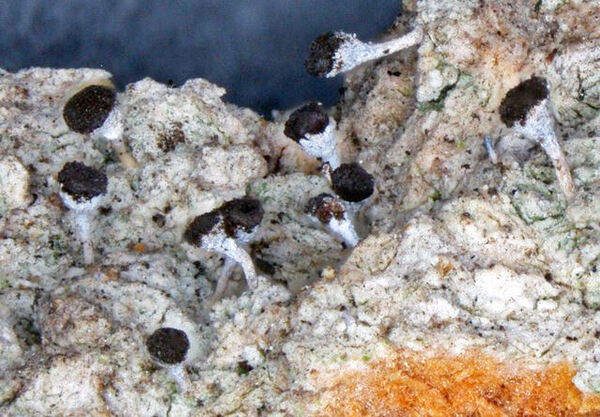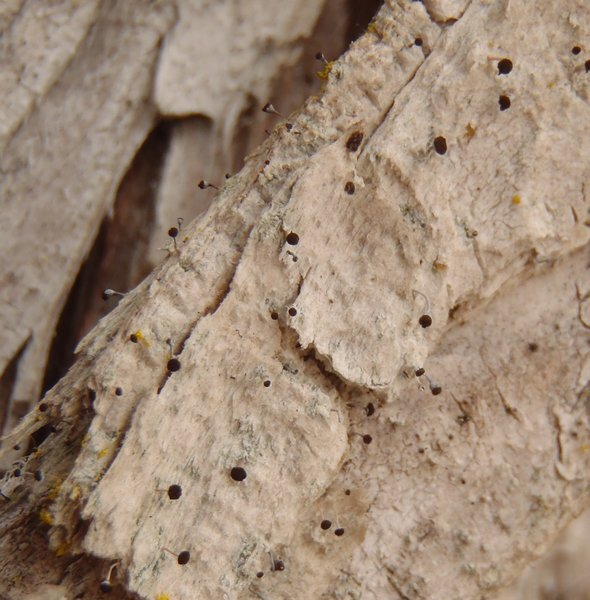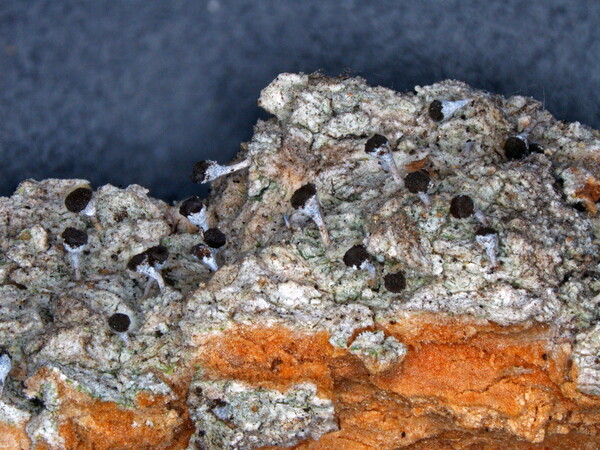Chaenotheca cinerea (Pers.) Tibell
Symb. Bot. Upsal., 23, 1: 30, 1980. Basionym: Calicium cinereum Pers. - Ic. Descr. Fung. Minus Cogn., 2: 58, 1800.
Synonyms: Calicium schaereri De Not. non auct.; Chaenotheca albida (Körb.) Zahlbr.; Chaenotheca schaereri (De Not.) Zahlbr.
Description: Thallus crustose, episubstratic, granular-verrucose, grey-white, more rarely almost endosubstratic and poorly evident. Apothecia short-stalked, pin-like, 0.6-1 mm high, the stalk 0.07-0.12 mm thick, the upper part dark, but covered in a thick white pruina, the lower part pale brown to almost white. Outermost layer of stalk hyaline, consisting of periclinally arranged, strongly gelatinized hyphae. Capitulum 0.2-0.4 mm across, obovoid to obconical, with a well-developed exciple which is white-pruinose in lower part, the edge often with very irregular vertical splits. Inner part of exciple of periclinally arranged, medium brown hyphae, the outer part of irregularly intertwined, swollen and sclerotized hyphae; mazaedium well-developed, brown; hypothecium pale brown to colourless, with a concave upper surface. Asci ellipsoid or irregular, estipitate, formed in chains from hooked ascogenous hyphae, dissolving early, with uniseriately arranged spores. Ascospores 1-celled, brown, globose, 4.5-5.5 µm wide, the wall smooth or with irregular cracks. Photobiont chlorococcoid, with rectangular cells (Stichococcus). Spot tests: thallus K-, C-, KC-, P-. Chemistry: thallus with very low amounts of atranorin and other unidentified substances.
Growth form: Crustose
Substrata: bark
Photobiont: green algae other than Trentepohlia
Reproductive strategy: mainly sexual
In underhangs rarely wetted by rain
Commonnes-rarity: (info)
Alpine belt: absent
Subalpine belt: absent
Montane belt: absent
Dry submediterranean belt: extremely rare
Humid submediterranean belt: absent
Padanian area: absent
pH of the substrata:
1 2 3 4 5
Solar irradiation:
1 2 3 4 5
Aridity:
1 2 3 4 5
Eutrophication:
1 2 3 4 5
Poleotolerance:
0 1 2 3
Altitudinal distribution:
1 2 3 4 5 6
Rarity
absent
extremely rare
very rare
rare
rather rare
rather common
common
very common
extremely common
Loading data...
Occurrence data
Predictive map
Growth form: Crustose
Substrata: bark
Photobiont: green algae other than Trentepohlia
Reproductive strategy: mainly sexual
In underhangs rarely wetted by rain
Commonnes-rarity: (info)
Alpine belt: absent
Subalpine belt: absent
Montane belt: absent
Dry submediterranean belt: extremely rare
Humid submediterranean belt: absent
Padanian area: absent
pH of the substrata:
| 1 | 2 | 3 | 4 | 5 |
Solar irradiation:
| 1 | 2 | 3 | 4 | 5 |
Aridity:
| 1 | 2 | 3 | 4 | 5 |
Eutrophication:
| 1 | 2 | 3 | 4 | 5 |
Poleotolerance:
| 0 | 1 | 2 | 3 |
Altitudinal distribution:
| 1 | 2 | 3 | 4 | 5 | 6 |
Rarity
absent
extremely rare
very rare
rare
rather rare
rather common
common
very common
extremely common
Loading data...
Occurrence data
Predictive map









